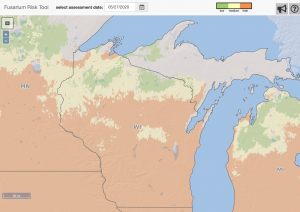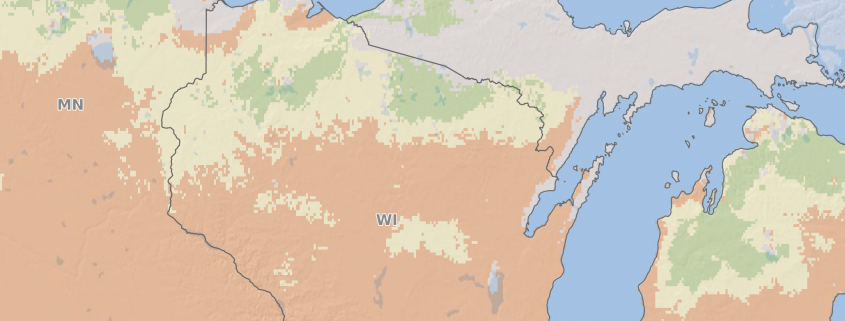Wisconsin Winter Wheat Disease Update – May 27, 2020
Damon Smith, Extension Field Crops Pathologist, Department of Plant Pathology, University of Wisconsin-Madison
Brian Mueller, Assistant Field Researcher, Department of Plant Pathology, University of Wisconsin-Madison

Figure 1. Fusarium Risk Tool prediction for FHB-susceptible varieties of winter wheat in Wisconsin on May 27, 2020.
Winter wheat in Wisconsin has responded to above average temperatures and rainfall, rapidly advancing through growth stages. In just a week or so, mainstems have rapidly elongated. In some varieties in southern and south-central Wisconsin, flag leaves are fully out. While now is a good time to consider a fungicide application, foliar disease has been non-existent in fields we have been in. We are monitoring the stripe rust situation carefully, and while it is active in states to our south, we have not observed any in fields we have scouted. The above average heat will also keep stripe rust moving slowly, especially in varieties with moderate resistance. So for now, I think we can hold off on fungicide. With margins being tight, I think it is wise to keep our fungicide application for Fusarium head blight (FHB or scab). Fungicides directed toward FHB are also effective against stripe rust, should it move in later in the season. Continue to scout fields between now and head emergence to catch any foliar diseases that might emerge.
Speaking of FHB, conditions have been VERY conducive for this disease in Wisconsin over the past week. The Fusarium Risk Tool is showing very favorable conditions for the entire state of Wisconsin for susceptible varieties (Fig. 1) and favorable conditions in the southern portion of the state for even moderately resistant varieties. This situation needs to be monitored over the next few days as heads start to emerge and anthesis (flowering) begins. Humid/wet and warm conditions will keep risk of FHB high as anthesis begins. We have also had several years of significant FHB and Gibberella ear rot in corn, meaning we have ample inoculum sources locally to initiate FHB epidemics. Farmers with winter wheat should be prepared to make a fungicide application if these conditions persist, especially those with wheat varieties rated as susceptible to FHB.
Remember that the best time to apply a fungicide for FHB control is at the start of anthesis, up to 7 days after the start of anthesis. In Wisconsin, our research has demonstrated that we can significantly reduce the levels of deoxynivalenol (DON or vomitoxin) in finished grain if we wait until 5 days after the start of anthesis to apply our FHB fungicide. This is due to the fact that we often have uneven head emergence in our fields and delaying applications a few days after the start of anthesis can let these heads (or those on secondary tillers) “catch up.”
Fungicides considered most consistent in efficacy in University research include Prosaro®, Caramba®, and Miravis Ace®. Efficacy ratings for these and other products can be found on the Crop Protection Network’s Fungicide Efficacy for Control of Wheat Diseases fact sheet. Results from fungicide efficacy trials from the Badger Crop Docs, can be found by CLICKING HERE. Research trials from 2019 that include the newest fungicide, Miravis Ace®, can be found by CLICKING HERE and scrolling down to the last several pages. Remember, that the goal is to reduce damage by FHB and reduce DON levels as far below 2ppm as possible. The ideal method to do this includes an integrated approach of using resistant varieties and well-timed fungicide applications. Continue to monitor the wheat disease situation closely and get out and Scout, Scout, Scout!





